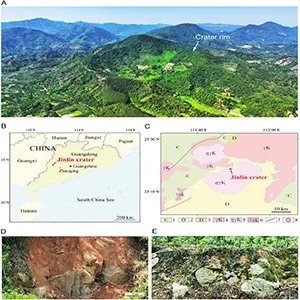
Massive meteor crater in China rewrites Earth's impact history
A team of researchers has uncovered a remarkably intact impact structure that is now known as the Jinlin crater. The crater is tucked into a granite hillside near Zhaoqing in Guangdong Province.
The finding stands out not just for its pristine condition, but for its timing. The crater likely formed in the early-to-mid Holocene – the same geological epoch we’re in now, which began roughly 11,700 years ago.
With a rim-to-rim span of about 2,953 feet (900 meters), Jinlin instantly becomes the largest known Holocene impact crater on Earth.
Jinlin dwarfs Russia’s 984-foot (300-meter) Macha crater, which previously held the title. The sheer scale suggests a dramatic collision by a relatively small extraterrestrial body.
“This discovery shows that the scale of impacts of small extraterrestrial objects on the Earth in the Holocene is far greater than previously recorded,” said study co-author Ming Chen.
Jinlin meteor crater frozen in time
Impact craters don’t last forever. Wind, water, and time soften their edges and smear their geometry. That’s why Jinlin’s condition is so surprising.
Southern China’s monsoon climate, characterized by heavy rains and high humidity, should have chewed away at the structure.
Instead, the crater sits cradled in a thick weathering crust atop granite, which seems to have helped armor its original shape.
Granite did more than protect the rim. Within these layers, the team identified quartz grains carrying planar deformation features (PDFs) – microscopic shock signatures that are the calling card of high-velocity impact.
“On Earth, the formation of planar deformation features in quartz is only from the intense shockwaves generated by celestial body impacts,” said Chen.
“Its formation pressure ranges from 10 to 35 gigapascals, which is a shock effect that cannot be produced by any geological process of the Earth itself.”
In other words, the rocks themselves testify to a violent moment no normal tectonic or volcanic event could produce.
What exactly hit Earth?
The crater’s footprint indicates the impactor was a meteorite rather than a comet. A cometary strike of similar energy would typically carve a feature at least 6.2 miles across.
But the team hasn’t pinned down whether the incoming rock was iron-rich or stony. That distinction matters.
Iron meteorites arrive as dense, coherent blocks that dig deeper and leave unmistakable geophysical traces. Stony meteorites usually break apart and disperse their energy differently.
Future fieldwork, including magnetic surveys, geochemical assays, and a search for shocked melt or tiny spherules, could provide the missing “forensic” details.
Jinlin crater shouldn’t exist
Planetary scientists often say that every patch of Earth’s surface has, in principle, faced equal odds of being struck over geologic time. What varies is preservation.
Oceans swallow seafloor craters; mountain building distorts and buries continental scars; weather scrubs the rest. That uneven erasure leaves gaps in our chronology of impacts, especially in the relatively recent past. It makes Jinlin’s survival unusually valuable.
“The impact crater is a true record of Earth’s impact history,” Chen said. “The discovery of an Earth impact crater can provide us with a more objective basis for understanding the distribution, geological evolution, and impact history and regulation of small extraterrestrial bodies.”
The research helps calibrate the rate at which small to mid-sized objects actually hit Earth. It will also help refine risk models for future impacts.

Insights from the Jinlin crater
Dating the crater to the early-to-mid Holocene relied on local erosion measurements and geomorphic context.
In other words, researchers looked at how fast the landscape around the crater wears down and how the structure fits within that evolving terrain
That approach, paired with the crater’s exceptional state, narrows its age more tightly than many other small, young craters worldwide.
The early Holocene was a period of deglaciation, rising seas, and shifting climates, Jinlin adds a discrete, high-energy event to that tapestry, one that may have left subtle traces in local deposits or ecosystems.
The Holocene focus also matters for impact statistics. Researchers have long debated how frequently subkilometer objects reach the ground with enough energy to form craters of this size.
Jinlin, at 2,953 feet across, forces a recalibration of how often such impacts occur and how well we’ve been detecting them.
Digging deeper from here
From here, the research will spread in two directions. One is forensic: confirming the impactor’s composition, mapping the subsurface structure, and hunting for melt lenses or ejecta that could refine the impact’s energy.
The other line of evidence is statistical and global. It involves comparing Jinlin to other Holocene candidates and requires reevaluating preservation biases in humid, high-relief settings.
For now, this hillside bowl in Guangdong offers a rare, sharp snapshot of a cosmic hazard that is easy to forget until it isn’t.
The discovery reminds us that Earth’s recent past includes more impacts than the official record shows. It also highlights that some of the best archives of planetary history are the scars the planet stubbornly refuses to heal.
The study is published in the journal Matter and Radiation at Extremes.
—–
Like what you read? Subscribe to our newsletter for engaging articles, exclusive content, and the latest updates.
Check us out on EarthSnap, a free app brought to you by Eric Ralls and Earth.com.
—–













